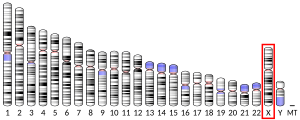Fanconi anemia group B protein is a protein that in humans is encoded by the FANCB gene.[5][6][7]
Function
editThe Fanconi anemia complementation group (FANC) currently includes FANCA, FANCB, FANCC, FANCD1 (also called BRCA2), FANCD2, FANCE, FANCF, FANCG, and FANCL. Fanconi anemia is a genetically heterogeneous recessive disorder characterized by cytogenetic instability, hypersensitivity to DNA crosslinking agents, increased chromosomal breakage, and defective DNA repair. The members of the Fanconi anemia complementation group do not share sequence similarity; they are related by their assembly into a common nuclear protein complex. This gene encodes the protein for complementation group B. Alternative splicing results in two transcript variants encoding the same protein.[7]
Gene
editFANCB is the only gene known to cause X-linked Fanconi Anemia. In female carriers of FANCB mutations (one wild-type FANCB allele and one mutant FANCB allele) there is strong selection through X-inactivation for expression of only the wild-type allele.[8] In contrast, males have only one FANCB allele. Only male patients with Fanconi anemia have ever been linked to FANCB mutations, and they make up about 4% of cases.[9]
Mutation in the FANCB are highly associated with the development of the VACTERL-H constilation of birth defects.[10] In a cohort study of 19 children with FANCB variants, those with deletion of FANCB gene or truncation of FANCB protein demonstrate earlier-than-average onset of bone marrow failure and more severe congenital abnormalities compared with a large series of Fanconi Anemia individuals in published reports. This reflects the indispensable role of FANCB gene in cells. For FANCB missense variants, more variable severity is associated with the extent of residual activity. [11]
Protein
editThe FANCB gene product is FANCB protein. FANCB is a component of a "core complex" of nine Fanconi Anemia proteins: FANCA, FANCB, FANCC, FANCE, FANCF, FANCG, FANCL, FAAP100 and FAAP20. The core complex localises to DNA damage sites during DNA replication where it catalyzes transfer of ubiquitin to FANCD2 and FANCI.[12] In particular, this reaction is necessary for the repair of DNA interstrand crosslinks, such as those formed by chemotherapy drugs cisplatin, mitomycin c and melphalan.[13]
Within the Fanconi anemia core complex, FANCB has an obligate interaction with FAAP100 and FANCL, to form a catalytic E3 RING ligase enzyme. FANCB creates a dimer interface within this subcomplex that is required for simultaneous ubiquitination of FANCD2 and FANCI.[14] Electron microscopy imaging of the FANCB-FANCL-FAAP100 complex revealed a symmetry that is centred on FANCB, and biochemical investigation confirmed that the entire complex is a dimer containing two of each subunit.[15] Further imaging reveals the overall architecture of the Fanconi Anemia core complex centres on FANCB protein.[15]
Meiosis
editFANCB mutant mice are infertile and exhibit primordial germ cell defects during embryogenesis. The germ cells and testicular size are severely compromised in FANCB mutant mice.[16] FANCB protein is essential for spermatogenesis and likely has a role in the activation of the Fanconi anemia DNA repair pathway during meiosis.[16]
References
edit- ^ a b c GRCh38: Ensembl release 89: ENSG00000181544 – Ensembl, May 2017
- ^ a b c GRCm38: Ensembl release 89: ENSMUSG00000047757 – Ensembl, May 2017
- ^ "Human PubMed Reference:". National Center for Biotechnology Information, U.S. National Library of Medicine.
- ^ "Mouse PubMed Reference:". National Center for Biotechnology Information, U.S. National Library of Medicine.
- ^ Joenje H, Oostra AB, Wijker M, di Summa FM, van Berkel CG, Rooimans MA, Ebell W, van Weel M, Pronk JC, Buchwald M, Arwert F (Nov 1997). "Evidence for at least eight Fanconi anemia genes". Am J Hum Genet. 61 (4): 940–4. doi:10.1086/514881. PMC 1715980. PMID 9382107.
- ^ Meetei AR, Levitus M, Xue Y, Medhurst AL, Zwaan M, Ling C, Rooimans MA, Bier P, Hoatlin M, Pals G, de Winter JP, Wang W, Joenje H (Oct 2004). "X-linked inheritance of Fanconi anemia complementation group B". Nat Genet. 36 (11): 1219–24. doi:10.1038/ng1458. PMID 15502827.
- ^ a b "Entrez Gene: FANCB Fanconi anemia, complementation group B".
- ^ Meetei AR, Levitus M, Xue Y, Medhurst AL, Zwaan M, Ling C, Rooimans MA, Bier P, Hoatlin M, Pals G, de Winter JP, Wang W, Joenje H (November 2004). "X-linked inheritance of Fanconi anemia complementation group B". Nature Genetics. 36 (11): 1219–24. doi:10.1038/ng1458. PMID 15502827.
- ^ Wang AT, Smogorzewska A (January 2015). "SnapShot: Fanconi anemia and associated proteins". Cell. 160 (1–2): 354–354.e1. doi:10.1016/j.cell.2014.12.031. PMID 25594185.
- ^ Fiesco-Roa MO, Giri N, McReynolds LJ, Best AF, Alter BP (September 2019). "Genotype-phenotype associations in Fanconi anemia: A literature review". Blood Reviews. 37: 100589. doi:10.1016/j.blre.2019.100589. PMC 6730648. PMID 31351673.
- ^ Jung M, Ramanagoudr-Bhojappa R, van Twest S, Rosti RO, Murphy V, Tan W, et al. (April 2020). "Association of clinical severity with FANCB variant type in Fanconi anemia". Blood. 135 (18): 1588–1602. doi:10.1182/blood.2019003249. PMC 7193183. PMID 32106311.
- ^ Walden H, Deans AJ (2014). "The Fanconi anemia DNA repair pathway: structural and functional insights into a complex disorder". Annual Review of Biophysics. 43: 257–78. doi:10.1146/annurev-biophys-051013-022737. PMID 24773018.
- ^ Ceccaldi R, Sarangi P, D'Andrea AD (June 2016). "The Fanconi anaemia pathway: new players and new functions". Nature Reviews. Molecular Cell Biology. 17 (6): 337–49. doi:10.1038/nrm.2016.48. PMID 27145721. S2CID 1712640.
- ^ van Twest S, Murphy VJ, Hodson C, Tan W, Swuec P, O'Rourke JJ, Heierhorst J, Crismani W, Deans AJ (January 2017). "Mechanism of Ubiquitination and Deubiquitination in the Fanconi Anemia Pathway". Molecular Cell. 65 (2): 247–259. doi:10.1016/j.molcel.2016.11.005. hdl:2434/618936. PMID 27986371.
- ^ a b Swuec P, Renault L, Borg A, Shah F, Murphy VJ, van Twest S, Snijders AP, Deans AJ, Costa A (January 2017). "The FA Core Complex Contains a Homo-dimeric Catalytic Module for the Symmetric Mono-ubiquitination of FANCI-FANCD2". Cell Reports. 18 (3): 611–623. doi:10.1016/j.celrep.2016.11.013. PMC 5266791. PMID 27986592.
- ^ a b Kato Y, Alavattam KG, Sin HS, Meetei AR, Pang Q, Andreassen PR, Namekawa SH (2015). "FANCB is essential in the male germline and regulates H3K9 methylation on the sex chromosomes during meiosis". Hum. Mol. Genet. 24 (18): 5234–49. doi:10.1093/hmg/ddv244. PMC 4550819. PMID 26123487.





